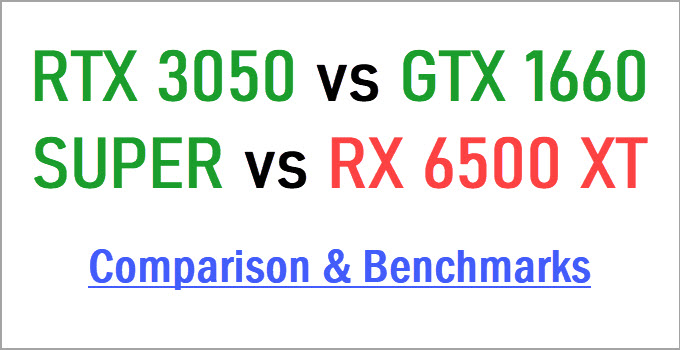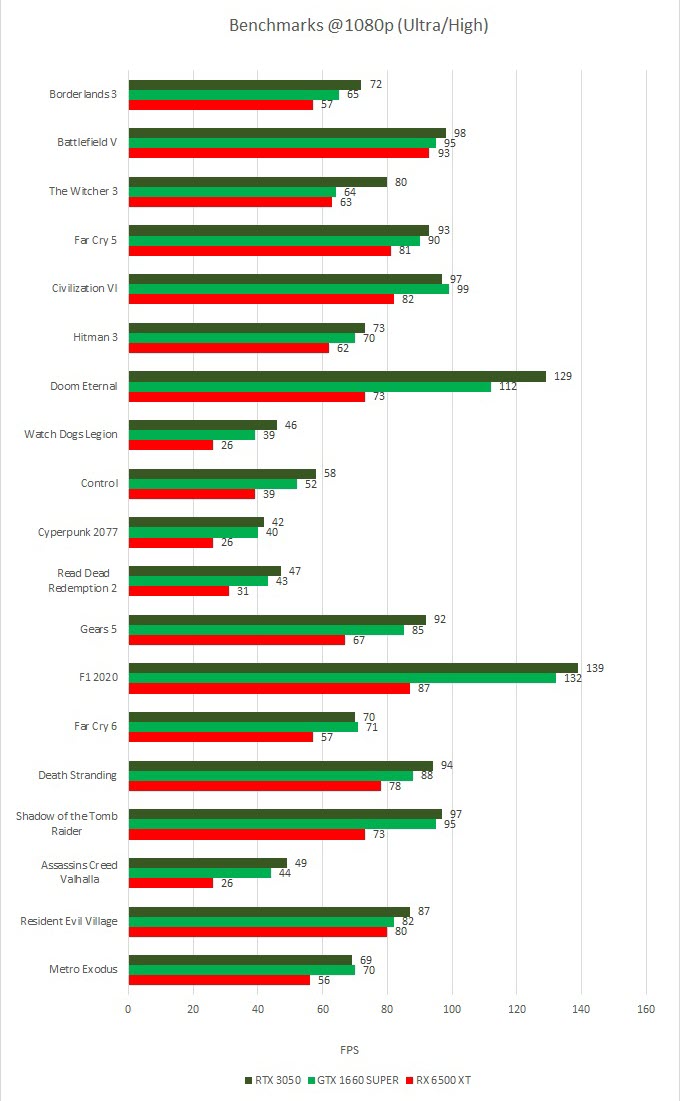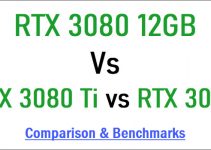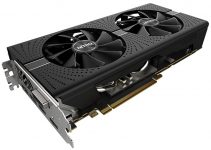The GeForce RTX 30 series graphics card lineup is further expanded by Nvidia by launching GeForce RTX 3050 which now forms the youngest member of the series. The card sits below the RTX 3060 in the series and is targeted mainly towards 1080p gaming and eSports gaming. The main competitors of RTX 3060 are the GTX 1660 Ti, GTX 1660 SUPER from Nvidia itself, and RX 6500 XT from AMD. Officially, you can say that RTX 3050 replaces the GTX 1650 but in reality, RTX 3050 is way faster and its performance falls in line with GTX 1660 SUPER and GTX 1660 Ti. Here I will be comparing RTX 3050 to its nearest competitors so that you can know about its features and performance, and whether it is worth buying or not over its major rivals.

RTX 3050 vs GTX 1660 SUPER vs RX 6500 XT Comparison
Below is the comparison between RTX 3050, GTX 1660 SUPER, and RX 6500 XT graphics cards based on their specifications, performance, pricing, power consumption, and features.
GPU Architecture
RTX 3050 is based on the Ampere GPU architecture and is built on the 8nm fabrication process. It uses GA106 GPU in a cut-down form and comes with 2560 CUDA Cores, 20 Ray Tracing (RT) Cores, and 80 Tensor Cores. GTX 1660 SUPER is one generation older card compared to RTX 3050 and is built on Turing GPU architecture on 8nm fabrication process. It uses TU116 GPU comes with 1408 CUDA Cores and does not have RT Cores and Tensor Cores. On the other hand, Radeon RX 6500 XT is an AMD graphics card and the first graphics card to be built on the 6nm fabrication process. It is powered by RDNA 2 GPU architecture and uses Navi 24 GPU. The card comes with 1024 Stream Processors and 16 Ray Accelerators or Ray Tracing Cores.
| RTX 3050 | GTX 1660 SUPER | RX 6500 XT | |
| GPU Chip | GA106 | TU116 | Navi 24 |
| GPU Architecture | Ampere | Turing | RDNA 2 |
| Fabrication Process | 8nm | 8nm | 6nm |
| CUDA Cores/Stream Processors | 2560 CUDA Cores | 1408 CUDA Cores | 1024 Stream Processors |
| Ray Tracing Cores | 20 | NA | 16 |
| Tensor Cores | 80 | NA | NA |
Video RAM [VRAM]
RTX 3050 comes with 8GB GDDR6 memory which is the highest among the three. The memory runs at 14 Gbps and has 128-bit bus width delivering a memory bandwidth of 224 GB/s. The card having the lowest memory and memory bandwidth is the RX 6500 XT. It comes with 4GB GDDR6 memory having a 64-bit interface, runs at 18Gbps, and produces a bandwidth of only 144 GB/s. The memory capacity of GTX 1660 SUPER falls in between RTX 3050 and RX 6500 XT as it comes with 6GB GDDR6 memory having a 192-bit interface and a memory speed of 14 Gbps. It generates a memory bandwidth of 336 GB/s, the highest of all three.
| RTX 3050 | GTX 1660 SUPER | RX 6500 XT | |
| Memory Size | 8GB GDDR6 | 6GB GDDR6 | 4GB GDDR6 |
| Memory Interface | 128-bit | 192-bit | 64-bit |
| Memory Speed | 14Gbps | 14Gbps | 18 Gbps |
| Memory Bandwidth | 224 GB/s | 336 GB/s | 144 GB/s |
Features
The card with the least number of features is the RX 6500 XT because it even lacks the hardware encoding and AV1 decoding that even two generations older cards support in the same or lower price range. The features supported by all three cards include support for DirectX 12 Ultimate, OpenGL 4.6, and G-Sync/FreeSync variable refresh rate technologies. Both RTX 3050 and RX 6500 XT support PCI-Express 4.0 but the RX 6500 XT only supports 4 lanes (x4) while RTX 3050 supports 8 lanes (x8). GTX 1660 SUPER supports PCIe 3.0 and runs at full x16 lanes. HDMI 2.1 is supported by RTX 3050 and RX 6500 XT only. Moreover, both RTX 3050 and RX 6500 XT support Real-Time Ray Tracing but DLSS is only supported by RTX 3050. So, in terms of features, RTX 3050 is the winner here as it supports almost all the latest modern-day features.
| RTX 3050 | GTX 1660 SUPER | RX 6500 XT | |
| Bus Interface | PCI Express 4.0 (x8) | PCI Express 3.0 (x16) | PCI Express 4.0 (x4) |
| DirectX | 12 Ultimate | 12 Ultimate | 12 Ultimate |
| OpenGL | 4.6 | 4.6 | 4.6 |
| Vulkan | 1.2 | 1.2 | 1.2 |
| SLI/CrossFire | No | No | No |
| VR Ready | No | No | No |
| G-Sync/FreeSync | Yes | Yes | Yes (FreeSync) |
| Hardware Encoding | Yes | Yes | No |
| HDMI 2.1 | Yes | No | Yes |
| Ray Tracing Support | Yes | No | Yes |
| Deep Learning Super Sampling (DLSS) | Yes | No | Yes |
Gaming Performance
Here are the benchmarks of these cards at 1080p resolution in the popular and latest AAA games.

From the above benchmarks, we can see that RTX 3050 is the fastest card while RX 6500 XT is the slowest. On average, RTX 3050 is 6 percent faster than GTX 1660 SUPER and way faster than RX 6500 XT.
Power Consumption
The card with the lowest power consumption is RX 6500 XT with 107W while RTX 3050 has the highest at 130W. The power consumption figure of GTX 1660 SUPER is 125W, slightly less than RTX 3050.
| RTX 3050 | GTX 1660 SUPER | RX 6500 XT | |
| Power Consumption | 130W | 125W | 107W |
| Recommended PSU | 550W | 450W | 400W |
Price & Availability
Talking only about MSRP at the launch, RTX 3050 is priced at $249, GTX 1660 SUPER at $229, and RX 6500 XT at $199. All prices are in USD. The custom models of these cards from AIBs do cost more depending on features and cooler used. You can check the current prices of these cards from the links given below.
Check RTX 3050 Price on Amazon
Check GTX 1660 SUPER Price on Amazon
Check RX 6500 XT Price on Amazon
RTX 3050 vs GTX 1660 SUPER vs RX 6500 XT Specifications
| RTX 3050 | GTX 1660 SUPER | RX 6500 XT | |
| GPU Chip | GA106 | TU116 | Navi 24 |
| GPU Architecture | Ampere | Turing | RDNA 2 |
| Fabrication Process | 8nm | 8nm | 6nm |
| CUDA Cores/Stream Processors | 2560 CUDA Cores | 1408 CUDA Cores | 1024 Stream Processors |
| Ray Tracing Cores | 20 | NA | 16 |
| Tensor Cores | 80 | NA | NA |
| Memory Size | 8GB GDDR6 | 6GB GDDR6 | 4GB GDDR6 |
| Memory Interface | 128-bit | 192-bit | 64-bit |
| Memory Speed | 14Gbps | 14Gbps | 18 Gbps |
| Memory Bandwidth | 224 GB/s | 336 GB/s | 144 GB/s |
| Bus Interface | PCI Express 4.0 (x8) | PCI Express 3.0 (x16) | PCI Express 4.0 (x4) |
| DirectX | 12 Ultimate | 12 Ultimate | 12 Ultimate |
| OpenGL | 4.6 | 4.6 | 4.6 |
| Vulkan | 1.2 | 1.2 | 1.2 |
| SLI/CrossFire | No | No | No |
| VR Ready | No | No | No |
| G-Sync/FreeSync | Yes | Yes | Yes (FreeSync) |
| Power Consumption | 130W | 125W | 107W |
| Recommended PSU | 550W | 450W | 400W |
See also:
- RX 6500 XT vs GTX 1650 SUPER vs RX 5500 XT Comparison
- GTX 1660 SUPER vs GTX 1660 Ti vs GTX 1660 vs RX 590 Comparison
Final Thoughts
Well, I think RTX 3050 is a pretty decent card and is way faster than RX 6500 XT. You can also say that it is almost at GTX 1660 SUPER with support for Ray Tracing and DLSS. The main advantage of RTX 3050 over its competitors is that it comes with 8GB VRAM which can prove handy in upcoming AAA games even at 1080p resolution. If you can get an RTX 3050 close to its base price or MSRP then I think it is a very good deal. If you have queries then feel free to ask them in the comment section below.
(*This post may contain affiliate links, which means I may receive a small commission if you choose to purchase through the links I provide (at no extra cost to you). Thank you for supporting the work I put into this site!)


